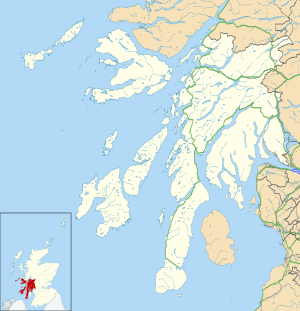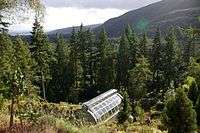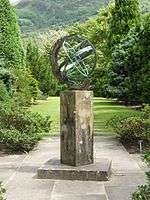Benmore Botanic Garden
Benmore Botanic Garden; formerly known as the Younger Botanic Garden, is a large botanical garden situated in Strath Eachaig at the foot of Beinn Mhòr, on the Cowal peninsula, in Argyll and Bute, Scotland. The gardens are on the west side of the A815 road from Dunoon, between the Holy Loch and Loch Eck, and include footbridges across the River Eachaig.
| Benmore Botanic Garden | |
|---|---|
 The avenue of Giant Sequoias at Benmore Botanic Gardens. | |
 Benmore Botanic Garden Location within Argyll and Bute | |
| OS grid reference | NS 14319 85507 |
| Council area |
|
| Lieutenancy area |
|
| Country | Scotland |
| Sovereign state | United Kingdom |
| Post town | DUNOON, ARGYLL |
| Postcode district | PA23 |
| Dialling code | 01369 |
| UK Parliament |
|
| Scottish Parliament |
|
| Website | http://www.rbge.org.uk/the-gardens/benmore |
Features include a Redwood Avenue of Giant Sequoias planted in 1863, large square walled gardens, a waterfall, a fernery, ponds and walks up the hillside to where you can look out across the Holy Loch. A cafe can be found at the entrance as well as a shop. The garden is located within the Argyll Forest Park, which is itself within the Loch Lomond and The Trossachs National Park.
History
The area once called "Innasraugh", meaning "the sheltered valley", was part of the hunting grounds of the Dukes of Argyll, and belonged to the Campbells of Ballochyle. It was reached by a ford across the River Eachaig at Uig, near modern Eckford house.[1][2]
Around 1820, Ross Wilson introduced tree planting with the first known coniferous plantation of forest trees in Cowal.[2] In 1849 the estate was bought by John Lamont, a wealthy sugar planter in Trinidad who had emigrated from Toward (near Dunoon) 48 years earlier. He arranged replacement of the previous manor house with the larger Benmore House, but died in 1850, a year before the house was completed. His nephew James Lamont inherited the estate, but then sold it and it went to various other owners in succession.[1]
Benmore Estate was bought in 1862 by James Piers Patrick, a wealthy American who carried out extensive work to the house, including construction of the tower.[1] He developed the garden, and in 1863 planted the Redwood Avenue of Giant Sequoias.[3]
In 1870 the Greenock sugar refiner and philanthropist James Duncan bought Benmore Estate, which he extended to include the adjacent Kilmun and Bernice Estates.[2][4] He arranged extensive plantings in the grounds, including more than six million trees around the estate, and added paths leading up a ravine 1 kilometre (0.62 mi) to the south on the east side of the road, making Puck's Glen a scenic attraction. He extended the east wing of the house with a gallery to house his major collection of paintings: during the summers of the summers of 1881 and 1882, these were seen by more than 8,000 visitors. In 1889 he had to sell his assets, including Benmore.[1][5]
Henry Younger of the Edinburgh brewer Younger's bought the estate in 1889, and with his son Harry George Younger made many improvements to the woods and gardens, with 40 staff employed to carry out maintenance.[3] They introduced many exotic shrubs and trees, and also demolished the gallery and conservatory at the house. In 1924 Harry George Younger gifted the estate to the nation for science and education purposes: the Forestry Commission took over most of the woodlands.[1] In commemoration of the improvements James Duncan had made to the estate, Younger provided a hut for Puck's Glen, to a special design by Sir Robert Lorimer, and "Puck's Hut" was dedicated to the memory of the botanist Sir Isaac Bayley Balfour.[2]
The Royal Botanic Garden Edinburgh (RBGE) was looking for a place to take the large collection of plants which the botanist George Forrest had brought from China, and the high rainfall at Benmore was ideal. In 1929 the Younger Botanic Gardens were opened as the first outstation of the RBGE.[3] In the 1930s the Forestry Commission established Kilmun Arboretum, to try out tree species in the humid climate conditions, planting large groups of trees rather than individual specimens.[6] Benmore house was used by the Forestry Commission for apprentice training, then in 1965 Edinburgh Corporation took it over as a schools outdoor education centre.[1]
Features
Benmore features many magnificent trees, some of which are over 150 years old. On first entering the garden, visitors are greeted by an imposing avenue of Giant Sequoias (Sequoiadendron giganteum) plus several Douglas-firs (Pseudotsuga menziesii). The impressive avenue was planted in 1863 and several of the trees exceed 45 metres (148 ft) in height. Benmore contains one of the finest collections of plants from Bhutan, including numerous rhododendrons. Many of the garden's original plants were grown from seed collected by famous plantsmen, such as Ernest Wilson and David Douglas, during their travels to Asia and Pacific North America. Some of these plant collectors were sponsored by the garden's original owners, the Younger family, who largely made their wealth from brewing.
The high rainfall and mild winters suit many of the more unusual species of rhododendrons, magnolias and nothofagus grown in the garden.
The River Eachaig runs through the gardens from Loch Eck to the Holy Loch.
Benmore is a satellite garden under the management of the Royal Botanic Garden Edinburgh, as is its sister garden Logan Botanic Garden[7] and Dawyck Botanic Garden.[8]
The Fernery, constructed in the early 1870s, fell into ruin after James Duncan lost his fortune. In 1992, Historic Scotland designated the fernery a category B listed building, describing it as "a rare structure and important as an integral part of the gardens at Benmore". It has since been restored, and re-opened to the public in September 2009.[9]
Benmore Outdoor Centre, in the former Benmore House, is an outdoor training centre for school groups, and for other organisations and family groups. It is managed by the Children and Families Department of the City of Edinburgh Council.[10]
See also
Other Royal Botanic of Edinburgh Gardens:
Gallery
.jpg) Benmore Botanic Garden
Benmore Botanic Garden View of the fernery
View of the fernery.jpg) Benmore Botanic Garden
Benmore Botanic Garden Rhododendron in bloom
Rhododendron in bloom Sundial in the Formal Gardens
Sundial in the Formal Gardens.jpg) Rhododendron 'James Barto' at Benmore Botanic Garden
Rhododendron 'James Barto' at Benmore Botanic Garden.jpg) The refurbished fernery
The refurbished fernery
References
- "Of Interest". Benmore Centre for Outdoor Learning, Dunoon Argyll, Scotland, UK. Retrieved 21 February 2017.
- Historic Environment Scotland. "BENMORE (YOUNGER BOTANIC GARDEN) (GDL00056)". Retrieved 6 March 2019.
- "Benmore Botanic Garden Feature Page on Undiscovered Scotland". Undiscovered Scotland. 1 July 1987. Retrieved 21 February 2017.
- McDonald Watson, Andrew (5 July 2010). James Duncan: An Enlightened Victorian. Scotland: Royal Botanic Garden Edinburgh. ISBN 978-1906129330.
- "Puck's Glen". Forestry Commission Scotland. Retrieved 24 February 2017.
- "Kilmun Arboretum & Puck's Glen". National Tree Collections of Scotland. Retrieved 21 February 2017.
- "Royal Botanic Garden Edinburgh - Logan Botanic Garden". Rbge.org.uk. 8 March 2016. Retrieved 16 January 2017.
- "Royal Botanic Garden Edinburgh - Dawyck Botanic Garden". Rbge.org.uk. 6 April 2016. Retrieved 16 January 2017.
- Gibby, Mary (2013). "The Benmore Fernery". www.buildingconservation.com. Retrieved 4 January 2014.
- "Looking For An Outdoor Adventure?". Benmore Centre for Outdoor Learning, Dunoon Argyll, Scotland, UK. Retrieved 21 February 2017.
External links
- Map sources for Benmore Botanic Garden
- Royal Botanic Garden Edinburgh - website
- Benmore Botanic Garden - website
- Images and some highlights of Benmore Botanic Garden - Monumental Trees - website
| Wikimedia Commons has media related to Benmore Botanic Garden. |